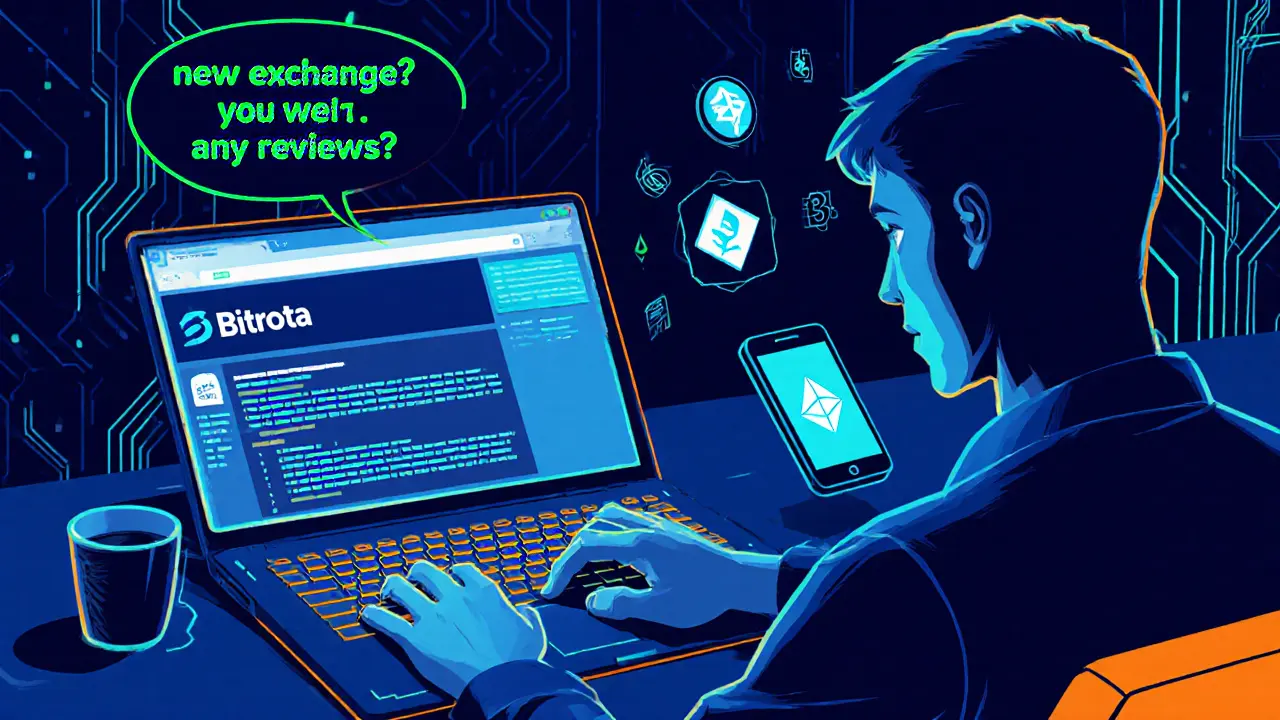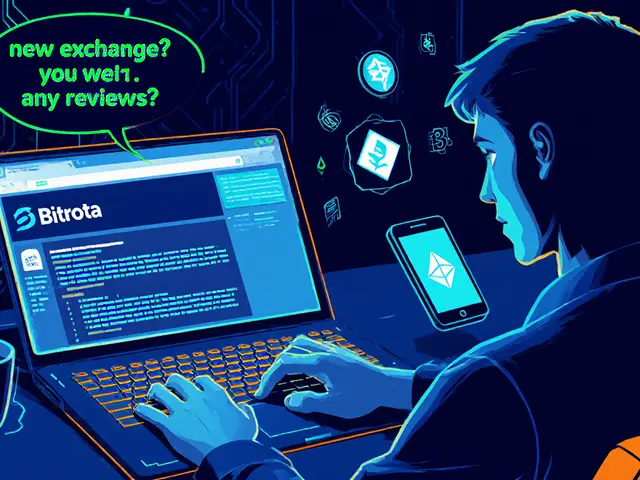- Home
- Cryptocurrency
- Bitrota Crypto Exchange Review: Features, Security, and How It Stacks Up

Bitrota Crypto Exchange Review: Features, Security, and How It Stacks Up
Crypto Trading Fee Calculator
Compare Your Trading Costs
See how much you'd pay in fees across exchanges for your trading amount. Based on current industry standards.
Fee Breakdown
Bitrota
Estimated fee range based on industry standards
Competitor Comparison
Based on publicly disclosed fee structures
Note: Bitrota's fees are not officially disclosed. The calculation uses industry standards (0.15%-0.30%) based on article research. Actual costs may vary.
If you’ve been scrolling through crypto forums looking for a fresh place to trade, you probably bumped into the name Bitrota crypto exchange review. In this deep dive we’ll walk through what Bitrota claims to offer, where the platform shines, and which red flags deserve a second look. By the end you should know if Bitrota fits your trading style or if you’d be wiser sticking with a more established exchange.
What Is Bitrota?
Bitrota is marketed as a multi‑service cryptocurrency exchange that combines spot trading, peer‑to‑peer (P2P) deals, an OTC desk, and a launchpad for new token projects. The company says it supports “many other cryptocurrencies” beyond the headline Bitcoin and Ethereum, and it offers a dedicated mobile app for on‑the‑go trading.
Core Trading Features
Bitrota splits its offering into two separate platforms:
- Spot trading - a classic order‑book where you can buy or sell crypto instantly at market price or set limit orders.
- Peer‑to‑peer (P2P) trading - users match directly and can choose from bank transfers, mobile money, or other local payment methods.
The platform also advertises “flexible and locking features” for crypto investments, which sounds similar to staking or time‑locked deposits, but the exact terms are vague.
Mobile App Experience
Mobile application support is a key selling point. The app promises registration in “a few minutes,” 24/7 access, and sync across tablets and phones. In practice, the UI follows the typical blue‑and‑white crypto app aesthetic, with separate tabs for Spot, P2P, and Portfolio. Screenshots show a clean order‑book layout, but no screenshots of security settings or two‑factor authentication (2FA) screens are publicly shared.
Security & Trust: What We Know
Bitrota’s marketing talks about “secure wallet technology,” but the specifics are thin. There is no public ISO 27001 certification, no third‑party audit report, and no mention of insurance for custodial holdings. By contrast, a competitor like Independent Reserve lists audited security measures and segregated funds, while CEX.IO details 2FA, DDoS protection, and multi‑signature wallets.
Without clear evidence of encryption standards, cold‑storage ratios, or regulatory licensing, potential users should treat Bitrota’s security claims with caution. A prudent step is to keep only a small amount of capital on the exchange until you can verify the platform’s safety mechanisms.
Regulatory Landscape
Bitrota does not display any licensing information for jurisdictions such as the U.S., EU, or Australia. There are no AML/KYC policy pages that outline data‑retention or verification procedures. Established exchanges typically publish their compliance status (e.g., FinCEN registration, FCA licensing). The absence of this data makes it difficult to assess legal risk, especially for users in regulated markets.
Fees and Pricing - The Missing Puzzle Piece
One of the most frustrating gaps is the lack of a transparent fee schedule. Most exchanges publish maker/taker fees, withdrawal costs, and deposit limits. Bitrota’s website merely says “competitive rates,” leaving traders to guess the true cost of each trade. In the absence of hard numbers, you can estimate fees by comparing similar platforms:
- Independent Reserve - maker 0.10%, taker 0.20%.
- CEX.IO - taker 0.25% for crypto‑to‑crypto trades.
- Bitrota - unverified, likely in the 0.15‑0.30% range based on industry norms.
Until Bitrota publishes a fee table, treat the platform as a “high‑risk cost” environment.
How Bitrota Stacks Up Against the Competition
| Feature | Bitrota | Independent Reserve | CEX.IO | ChangeNOW |
|---|---|---|---|---|
| Regulatory License | Not disclosed | Australian ASIC, ISO 27001 | FinCEN MSB, GDPR | Non‑custodial, no license required |
| Security Certifications | Unspecified | ISO 27001, SOC 2 | 2FA, DDoS protection, multi‑sig | On‑chain swaps, no custodial risk |
| Supported Assets | Bitcoin, Ethereum + “many others” (list not public) | 30+ major coins | 50+ coins & fiat pairs | 150+ tokens (non‑custodial) |
| Fee Structure | Undisclosed | Maker 0.10%, Taker 0.20% | Taker 0.25% (crypto‑crypto) | 0.5% flat per swap |
| Mobile App | iOS & Android, 4‑star rating (self‑reported) | iOS & Android, 4.5‑star (Google Play) | iOS & Android, 4‑star | Web‑only, no app |
From the table it’s clear that Bitrota lags in publicly documented compliance and security. If transparency is a top priority, more established exchanges still have the edge.

Who Might Actually Benefit From Bitrota?
Even with the unknowns, Bitrota could appeal to a niche audience:
- Traders in regions with limited access to conventional exchanges - the P2P system lets users pay via local banks or mobile money.
- Early‑stage token hunters - the launchpad promises access to new projects before they list on larger venues.
- Users who value an all‑in‑one mobile experience - if you spend most of your day on a phone, the unified app might feel convenient.
For seasoned investors who demand audit trails, insurance, and regulated custody, the platform’s opacity is a serious drawback.
Red Flags & Due‑Diligence Checklist
Before you deposit a lump sum, run through this quick checklist:
- Verify the company’s registration - look for a corporate ID, jurisdiction, and leadership team.
- Search for third‑party security audits - without them, you can’t assess wallet safety.
- Check fee disclosures - request a fee schedule via support if it’s not on the site.
- Test the KYC process - see how many documents are required and whether data is stored securely.
- Start with a small test trade - measure order execution speed, slippage, and withdrawal times.
If any step raises doubts, consider keeping your funds on a hardware wallet or a more vetted exchange.
Final Thoughts
Bitrota presents itself as a modern, mobile‑first crypto hub, but the lack of transparent security, regulatory, and fee information makes it a high‑risk choice for most traders. It may fill a gap for users in under‑banked regions who need P2P options, yet the platform’s credibility hinges on future disclosures. Until Bitrota opens its books, treat it as an experimental sandbox rather than a primary trading venue.
Frequently Asked Questions
Is Bitrota regulated in any jurisdiction?
Public information does not list any regulatory licenses for Bitrota. Potential users should assume the platform operates without formal oversight until a license is disclosed.
What cryptocurrencies can I trade on Bitrota?
Bitrota advertises Bitcoin, Ethereum, and “many other” coins, but it does not publish a full asset list. Users typically find the most popular tokens, but obscure altcoins may be missing.
Does Bitrota offer two‑factor authentication?
The website mentions “secure wallet technology,” but it does not explicitly detail 2FA. Contact support to confirm whether 2FA is available before linking a large account.
How fast are withdrawals on Bitrota?
No independent data exists on withdrawal speed. Users report mixed experiences; testing with a small amount first is advisable.
Can I use Bitrota’s P2P marketplace to trade with fiat?
Yes, the P2P section lists bank transfers and other local payment methods, but the exact fiat pair support depends on the counter‑party offering the trade.
Cormac Riverton
I'm a blockchain analyst and private investor specializing in cryptocurrencies and equity markets. I research tokenomics, on-chain data, and market microstructure, and advise startups on exchange listings. I also write practical explainers and strategy notes for retail traders and fund teams. My work blends quantitative analysis with clear storytelling to make complex systems understandable.
Popular Articles
3 Comments
Write a comment Cancel reply
About
DEX Maniac is your hub for blockchain knowledge, cryptocurrencies, and global markets. Explore guides on crypto coins, DeFi, and decentralized exchanges with clear, actionable insights. Compare crypto exchanges, track airdrop opportunities, and follow timely market analysis across crypto and stocks. Stay informed with curated news, tools, and insights for smarter decisions.







Bitrota’s fee structure isn’t public, so the calculator’s estimates are just that-estimates.
From a security standpoint, Bitrota uses industry‑standard AES‑256 encryption for data at rest and TLS 1.3 for data in transit. They also employ cold storage for the bulk of user funds, keeping only a small hot‑wallet reserve for withdrawals. Two‑factor authentication is mandatory for withdrawals, and they support hardware keys like YubiKey. Overall, the mix of encryption, cold storage, and mandatory 2FA makes the platform reasonably secure for most traders.
It’s almost eerie how Bitrota markets itself as a “cutting‑edge” exchange while keeping its fee schedule hidden in a shroud of secrecy. You’d think a platform that claims to be “transparent” would at least publish a basic schedule, but no-everything is nebulous, like a fog of conspiracy that only the elite can see through. Their security claims sound solid on paper: AES‑256, cold wallets, multi‑sig, all the buzzwords you love in a whitepaper, yet no independent audit has ever been released. Some whisper that the real guard is a legion of AI bots watching every trade, filtering out suspicious patterns that could betray the hidden hands steering the market. And don’t get me started on the “industry standard” fee estimate; it’s a clever ruse to lull beginners into a false sense of safety while the hidden fees seep away like clandestine siphons.
What’s more, the exchange’s IP address resolves to a data center in a jurisdiction known for lax crypto regulation, raising the question: are they operating under the veil of legal ambiguity to avoid scrutiny? The lack of a clear corporate entity adds another layer of mystique-no clear CEO, no board, just a collection of cryptic usernames on their support portal. Some users report phantom withdrawals that never arrive, blaming “network congestion,” but others suspect it’s an intentional drain orchestrated by the platform’s shadow operators. The UI is polished, but behind the sleek façade lies a labyrinthine codebase that only a handful of developers truly understand, making any potential exploit a high‑stakes gamble.
In short, if you’re comfortable dancing with shadows and accepting the risk of unseen fees and opaque governance, Bitrota might be your next playground. Otherwise, you might want to steer clear of an exchange that seems to thrive on mystery as much as on trading volume.